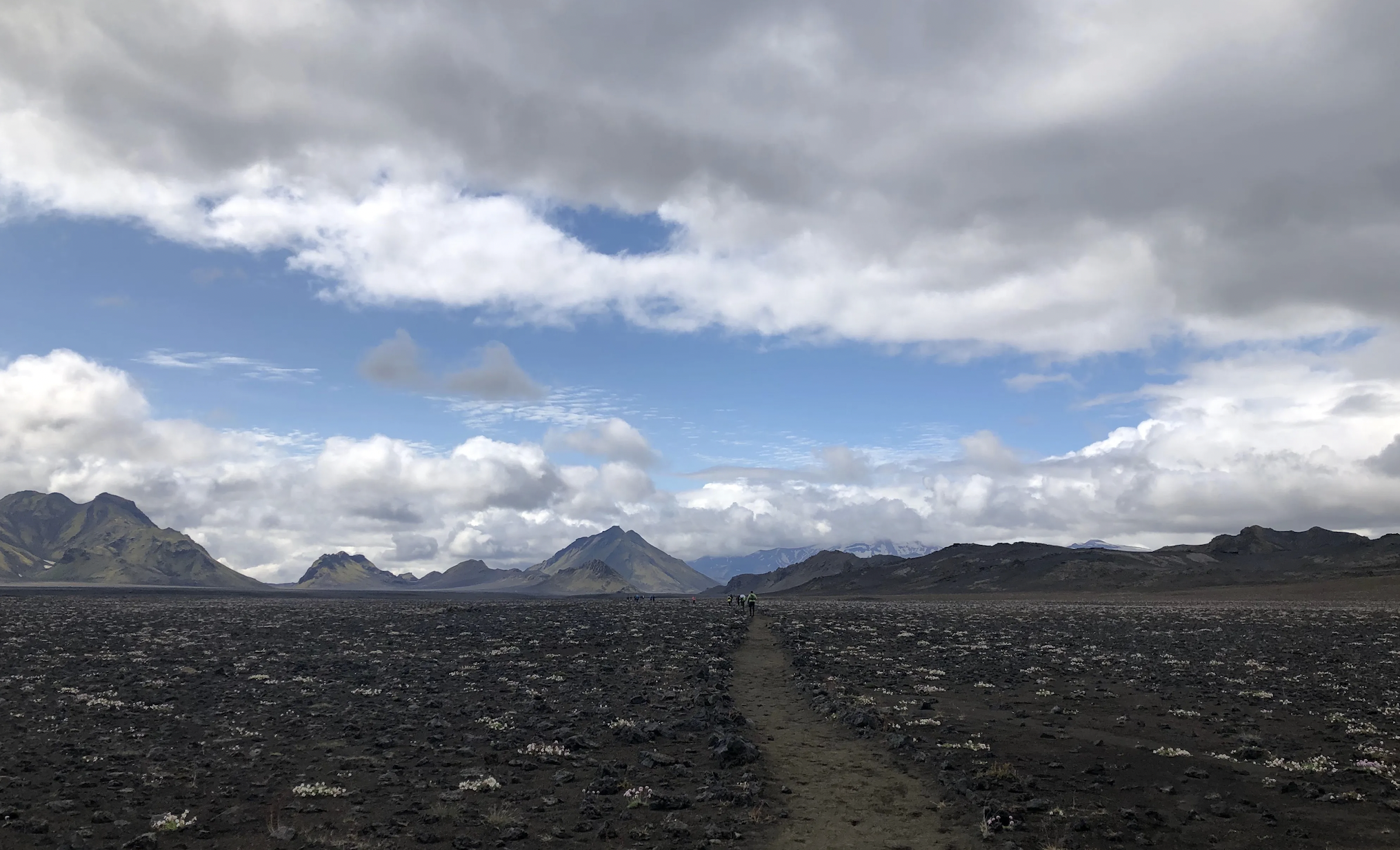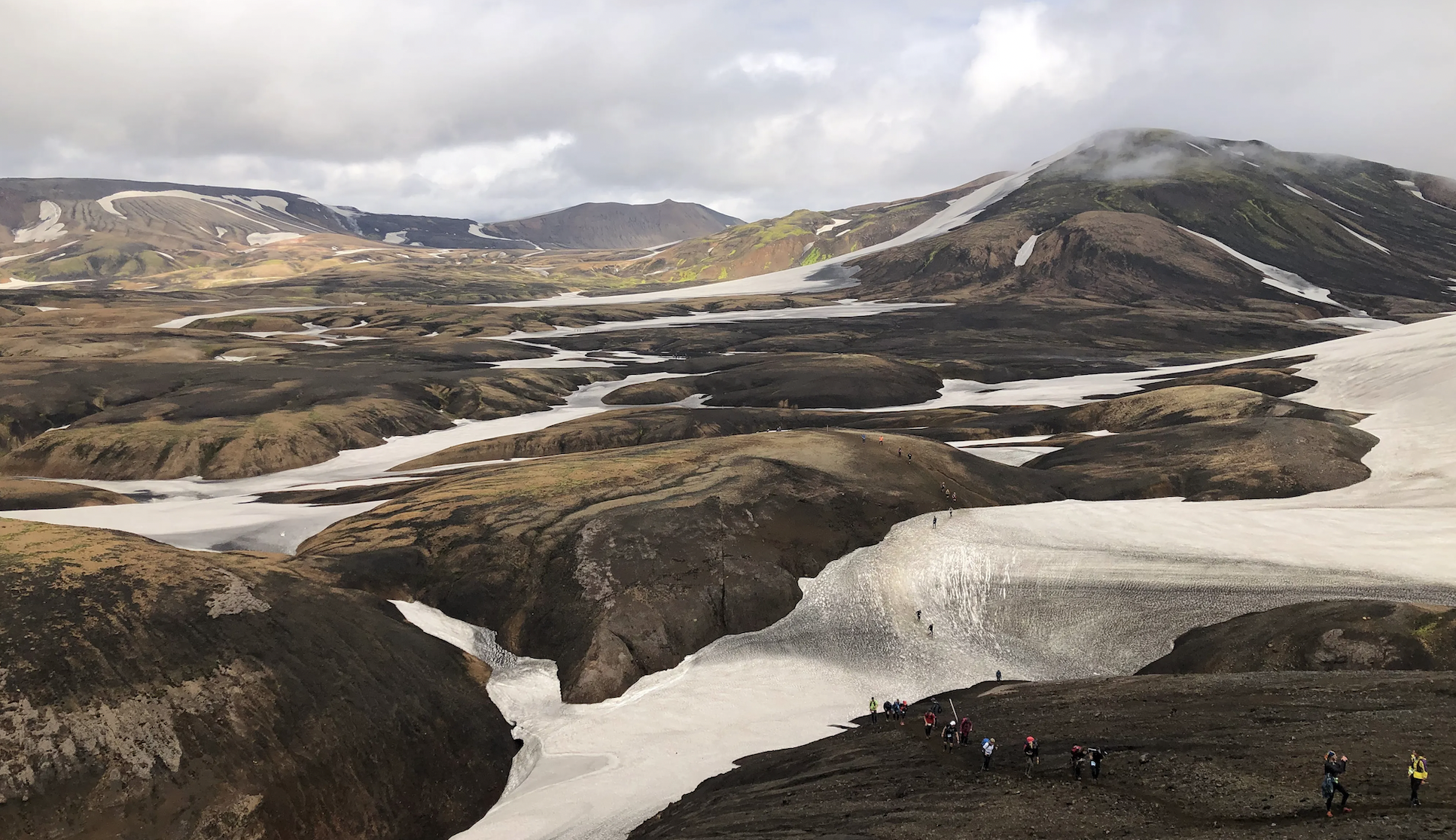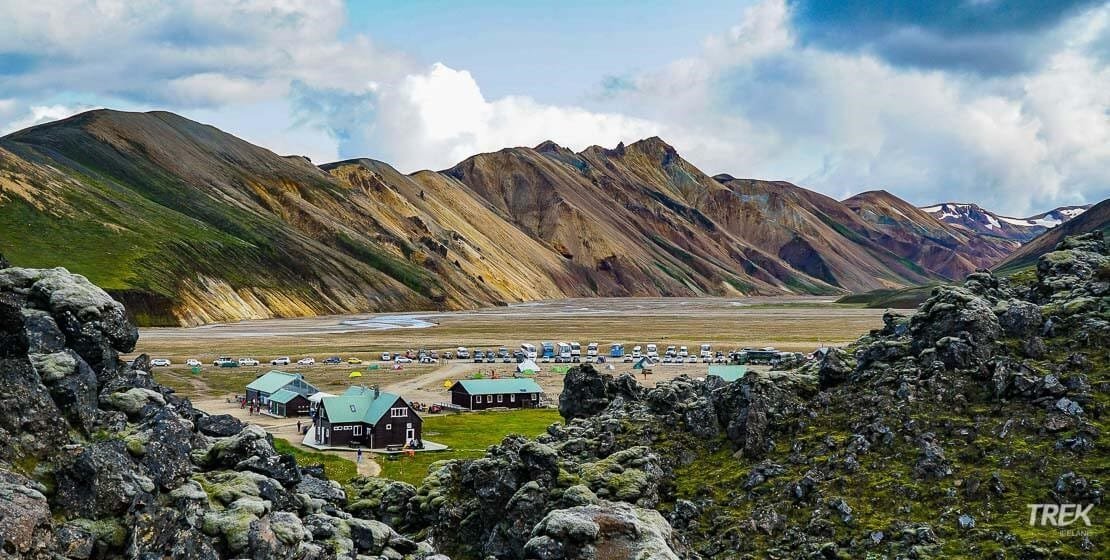
35 Miles On the Moon
Running Iceland’s Laugaveguenr 55k Ultra Marathon
I am Matt Damon.
I am Mathew McConaughey.
I am both Matt and Mathew, a ruggedly handsome spaceman exploring a world that is not my own. The alien surroundings are unfamiliar but with the training, discipline, and a well-written script, I am navigating the unknown with a lustful stoicism and medieval confidence that assures viewers this impossible mission will be absolutely accomplished. It’s good to be the Matts, I think.
It’s very good.
All of this, of course, is total horseshit, but it’s the conversation I’m having with myself 4 hours after the starting gun at the Laugavegur 55k fired in the Highlands of southeastern Iceland.
I’m surrounded by nothing but nothing. A vast, endlessly flat “field” of powdered grey/black volcanic rock pockmarked to infinity with other, somewhat bigger grey/black volcanic rocks. I’m on a well-traveled doublewide trail that flaccidly meanders toward more nothingness in the distance. It’s surreal, it’s isolated, it’s beautiful. And it’s a perfect place for 20+ mph headwinds to facepunch my progress.
My Apple Watch (an awful choice for races) says I’ve covered 16 miles of lifeless, mountainous terrain and there is no reason I should be feeling as good as I am. I say that because Minnesota is a terrible place to train for mountain races, being that there are, in fact, no mountains, and my mileage had been less than what most would consider considerable.
Also I was on production for ten days before the trip. Also because jetlag and no sleep and the 4am, 4.5-hour off-road bus ride to the starting lines. Also blah blah blah. So yeah, I shouldn’t be feeling this good, but I am, so I shut myself up about it and keep going.
Hours before my DamoConaughey fantasy, the race began at a parking lot in the Fjallabak Nature Reserve, a trailhead and geothermic area where hikers typically start or finish their traverse of the Laugavegur Trail.
The race itself is a challenging, 35-mile point to point, with roughly 5000 feet of gain and 6000 feet of loss, with minimal aid stations and maximum scenery. Today, in its 27th year, the race boasts a field of four heats and roughly 550 runners from around the world, making this year the largest group of runners since its inception.
The first section covers about 12 km/7.5 miles (I use kilometers now because I am an international ultra marathoner) and begins with a sharp, dramatic 1500-foot climb up twisting, hard-packed single track. Right away, we’re hike/running near bubbling geothermic activity and passing through clouds of fragrant, sulfuric fog.
The smell is horrendous but its drowned out by epic, rhyolite mountains in the near distance. Their slopes are perfectly tapered and shaped by ravines of deep water runoff. The rusty, burnt brown iron and green-mossed facades preside over valleys of nothing, and distant peaks are capped in snow. Even further out, a rounded, dome-like glacier hovers like a blanket over the landscape.
Everyone remembers their first glacier.
This first section is a wakeup call. I am undertrained, under-climbed, and under no delusions that I am prepared for this race. But while my quads are at attention, I find myself plodding across 500 meters of snowpack and cruising past the flatulent vents in the ground to care.
I dub these geothermic orifices Earth’s Buttholes because it makes me laugh and I am a mature adult person.
I crest a few steep climbs, drop a little, climb some more, drop, climb, drop, climb, until I eventually arrive at the first water stop to fill my excellent new Nathan Vaporair 2.0 hydro pack I picked up at my local running store, Mill City Running.
The next section covers 17 km/11 miles and features more buttholes, more snowpacks, more dumbfounding views. Overall, this section dropped about 1500-feet and crossed a few shallow rivers. It’s the highest section of the course and boasts one of the most technical and comically steep switchback descents I’ve ever run. Turns were sharp, strides were impossible, rocks and scree slid and crumbled underfoot. Fun, but slow.
Just prior to this giant switchback descent, we crested a peak and were treated to an enormous panorama of the next few hours of our day. Out in the distance, the breathtaking Alftavatn Lake laid in wait in the valley, surrounded by black-green mountains. An aid station waited at the 22 km/13.6 mile mark and had a strict 4-hour cutoff. I reach it in 3:13 and treat myself to a giant salt pill and half a warm banana. Five stars.
My phone has service again so I text my wife Allison, informing her of the scenery and that I am, at this point, still alive.
We’d crossed a handful of shallow, cold, rolling rivers at this point so my socks and feet were good and soggy.
My Nike Tiger 5s drained adequately and were performing well, but are still undeniably hideous. These are easily the ugliest shoes I’ve ever worn, and that’s saying a lot since I’ve run mostly on New Balance, a company that makes good shoes but stops short of making them look like anything less than poorly conceived dumpster fires.
We cross a bridge over the Bláfjallakvísl River (pronounced: Bláfjallakvísl) and I retrieve my drop bag. I have a rule during races to change nothing equipment-wise if I can help it, but I make an exception to change socks and it’s a game changer. It’s easily the best decision I’ve made thus far and make the switch from wet, candy orange Injinji socks to a more respectable and businesslike black. I immediately begin to take me and my feet more seriously.
At this point we catch up to the Damon/McConaughey portion. This is section three of the race and covers about 17 km/10.5 miles. It’s flat and cushy, and I fight forward into a strong headwind, singing a song I made up about wind. Here are a few of its Lennonian lyrics:
I love a good headwind
‘Cuz headwinds are my friend
If it weren’t for headwinds
I would have no friends.
This song, when sung properly and in the key of Whatever, can and should go on forever. Which it did.
Trail-wise, the well worn track had a luxurious blend of hard and soft sand. A little bit of hard pack country, a little bit of volcano dust rock and roll, etc. The slight cushion was glorious and despite the occasional river crossing, I make great time.
Since this is the Laugavegur Trail and is more popular with through-hikers than ultra marathoners, I passed dozens of grubby backpackers of all nationalities and dispositions. Most were moving slowly, bent slightly into the wind, and most were in good spirits. For them, the route will take about four days to traverse. For us, it would take no longer than 9 hours and 15 minutes, the official race cutoff.
The end of the third section offers a long, sustained descent to Emstrur, one of the shortest and most pronounceable names on the course.
(Em-strur. Nailed it.)
The aid station was a welcome sight as my water was running low. It’s ski-chalet-like structure tucked neatly into a canyon and fully stocked with cold water, blue Powerade, less warm bananas, pretzels, and Coca Cola. I opt for about 16 ounces of Coke because it’s goddamned delightful and I needed the caffeine kick. I fill my Nathan, say my thank yous, and take off for the final 17 km/10.5 miles of the race.
I leave the aid station feeling pretty worked, but still incredibly happy to be out there running. After experiencing hours of gentle, uncharacteristic race calm, the concept of Shinrin-Yoku aka Forest Bathing begins to make sense to me. Total isolation. No service. No wifi. No toxic electromagnetic energy. I’m blissful and energetic despite my sore quads and annoying lower back. There is something to this, I think. Something profound.
Then I catch my foot on a small rock and almost eat shit into a rock bed. Serves me right for being blissful.
As I leave the aid station and make my way to a river crossing and short climb out of the canyon, I meet a nice Canadian woman who’s running with her boyfriend after vanning around Iceland for 8 days. We say hi, I say I love Canada, and we go on. Just another pleasant trail interaction with a stranger until I see them again on the bus ride home, where they offer me a tip in the northern part of Iceland we can’t miss. (See epilogue)
For this final section, we climb out of the canyon and back onto more mountainous terrain. Beautiful rollers, exposed stretches of winding singletrack, green moss on black mountains, and a bridge crossing a powerful, canyon-cutting river make the final stretch just memorable as the miles leading up to it.
I crest a hill at mile 32 and my quads make it known they would like to stop working right this moment thank you very much, and I take note, literally with every step. Mercifully, they don’t cramp, but the fast, steep descents keep coming and my legs are on the bad side of feeling good. I descend into the final river crossing laughing at my legs and spend a long minute in the ice-cold water to give them a break. It’s brutally cold, feels great, and it gives me a boost to finish the final few miles.
The last mile was a twisty track canopied by the only shade on the entire course. I pass spectators and a handful of runners. I’m stoked, cruising, finding the extra push that always comes from knowing I get to stop running soon.
I pull out of the forest, round a corner, and make a right into the finish corral, surrounded by cheering spectators. I cross the finish line, am handed a metal, and just like that, 8 hours and 21 minutes had passed in what feels like a long, beautiful minute.
This race was the most fun I’ve had running since the last ultra I’d done the year prior near Mt. Hood. The Laugavegur 55k was a bonkers course through insane terrain and we were lucky to have the best weather imaginable. The race organizers deserve high praise for the incredible organization, their communication leading up to the race, and for making international travelers thoroughly comfortable with the daunting logistics. The finish was festive and well-stocked with food (included with bib) and beer (for purchase), and the transport back to Reykjavik was effortless.
If you’re thinking about doing this race, do this race. Sign up for 2020 the instant registration opens. I cannot recommend it highly enough. Then take eight days to drive around Iceland. To say it’s amazing doesn’t do it justice.
EPILOGUE
The friendly Canadians mentioned earlier implored us to visit the Bjórbödin Beer Spa in the northern region of Árskógssandur, which a few days drive from Reykjavik. It’s exactly what you think it is: a cool, modern building next to a giant body of water surrounded by even bigger, snowcapped mountains where you bathe in a hot tub filled with beer ingredients and drink beer while you do it. Yes, bathing in the stuff beer is made while drinking the stuff that’s actually beer.


























